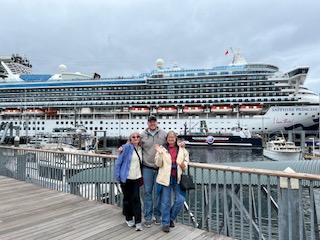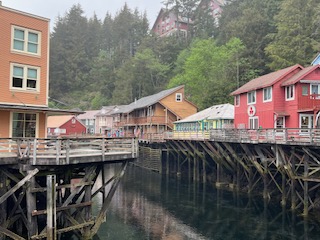May 19. After two days of stunning views, a ridiculous amount of food and alcohol, great family/friend time, ship “exploring” (we were often “adrift,” “off-course” and “at sea” on the huge ship, if you get my nautical references), cruise shows, wine tastings and games (did we mention Team Sal, BB, John, Bev and Fran won the Alaska Trivia contest?), we landed at our first port, Ketchikan, the southern entrance to Alaska’s famed Inside Passage, which can only be reached by air or sea.
Ketchikan is one of the rainiest places in North America, receiving an average of 160 inches of rain (“liquid sunshine”) a year; that’s 13 feet of rain! It is located in the heart of Tongass National Forest, the largest rainforest in North America, so rainfall is to be expected.
Today, approximately 19% of Ketchikan’s residents are of Tlingit, Haida and/or Tsimshian descent, and the numerous totem poles throughout town tell the histories of these people. We visited Saxman Totem Park, which is home to 25 totems that are authentic replicas of original poles that were left in abandoned villages as Native Alaskans moved into more populated areas. We met and spoke with Nathan Jackson, master carver, whose work is featured in the Smithsonian Museum of the American Indian and who was awarded the National Heritage Fellowship from the National Endowment of the Arts, our country’s highest honor for folk art. A guide pointed out features of various totem poles and explained the stories they told. There was an amusing story about William Seward, whose unflattering appearance was atop a shaming totem. Steward, who had helped arrange the purchase of Alaska from Russia, had visited the area and had been honored at three potlatches, ceremonial feasts where possessions are given away to show wealth and generosity. Apparently Steward was not told that potlatches were to be reciprocated, and sailed away with just a thanks, resulting with his head on the shaming pole.
Nathan Jackson
Creek Street was most known for its brothels. One of Ketchikan’s first was Dolly’s House, now displaying the slogan “Where Both Men and Salmon Came Upstream to Spawn.” The origins of the red light district lie in a 1903 city ordinance that banished brothels from the city center but allowed them on the east side of the creek, where they operated legally until 1954. During the 1920s, Ketchikan was home to more than 20 houses of ill repute, making it the top industry in the area. Today the historic district is lined with brightly colored houses hoisted on pillars above the creek. A wooden plank boardwalk takes you past the previous brothels that are now mostly gift shops.
And John got a hot dog.
is everywhere in Ketchikan, from a colorfully painted city bus to Chief Johnson’s Totem Pole at the center of town.
Ketchikan boasts the largest number of totem poles in Alaska, a collection that includes recently carved poles and some that are more than 100 years old. The Totem Heritage Center, which offers classes
The evidence of Native Alaskans is everywhere in Ketchikan, from a colorfully painted city bus to Chief Johnson’s Totem Pole at the center of town.
Ketchikan boasts the largest number of totem poles in Alaska, a collection that includes recently carved













.jpg)

No comments:
Post a Comment